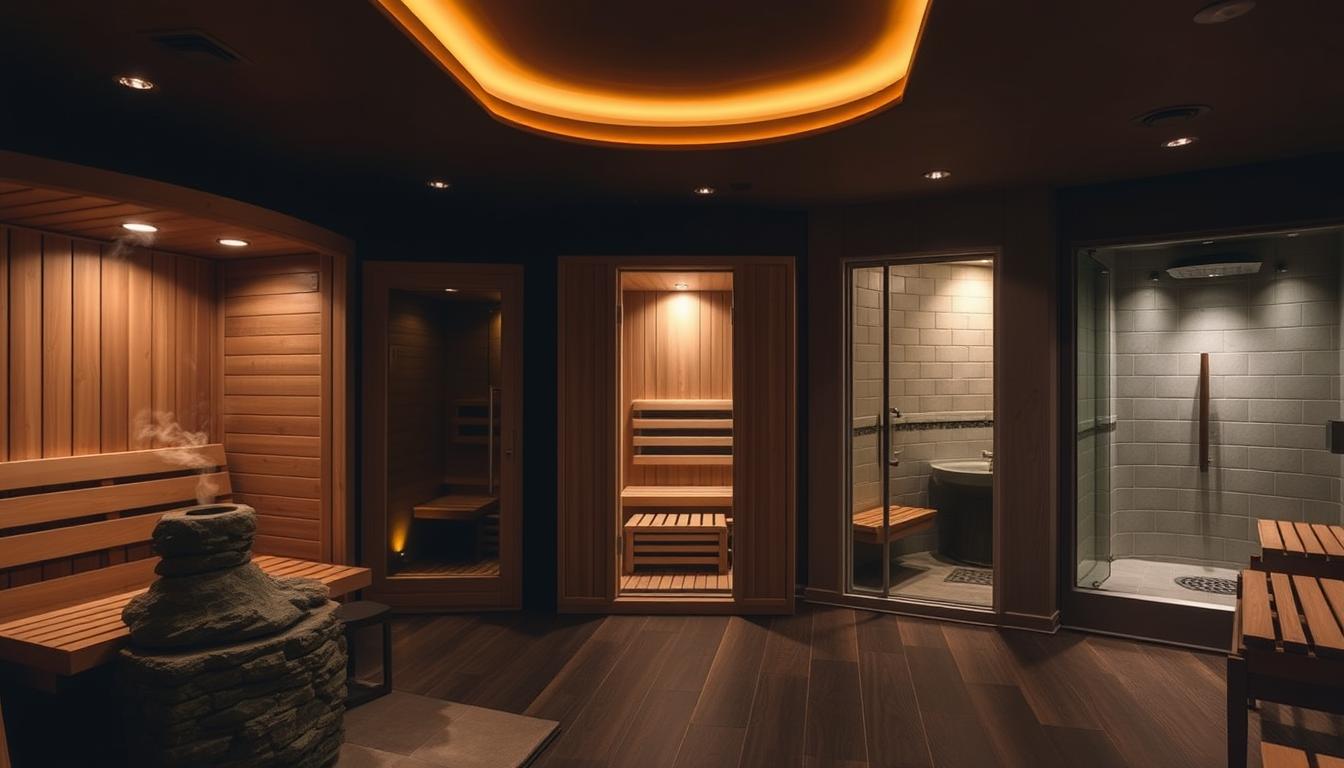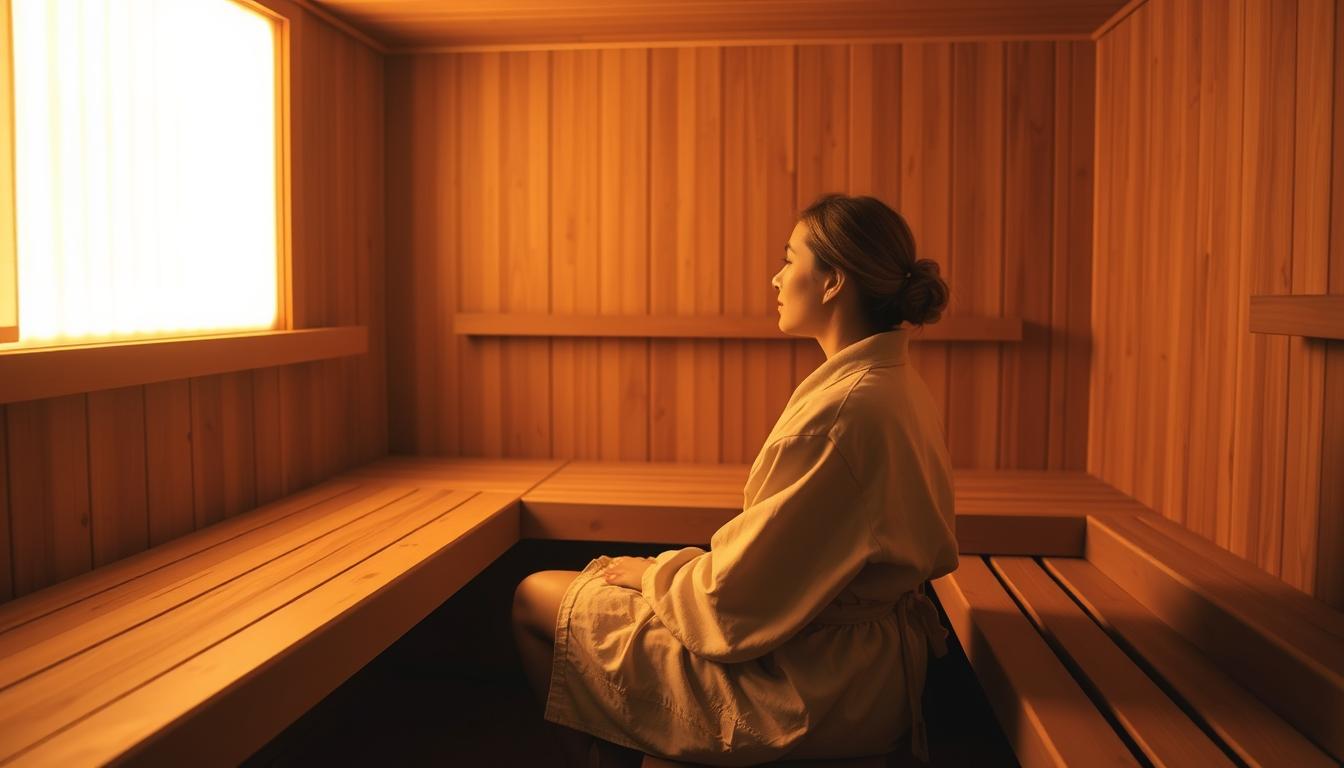
When to Use the Sauna: A Guide
Regular sauna use has been linked to various health benefits, including detoxification and relaxation. Incorporating a sauna routine into your lifestyle can be a great way to unwind and rejuvenate. But, understanding the best times to enjoy the sauna can enhance your experience.

Using a sauna can be a great addition to your wellness routine, offering numerous physical and mental health benefits. By understanding how to effectively incorporate sauna sessions, you can maximize its advantages.
Key Takeaways
- Sauna use can aid in detoxification and relaxation.
- Incorporating sauna sessions can enhance overall well-being.
- Understanding the best times for sauna use can improve the experience.
- A sauna routine can be a valuable addition to a wellness regimen.
- Regular sauna use is associated with various health benefits.
The Science Behind Sauna Benefits
Sauna benefits extend far beyond relaxation, with research uncovering significant physical and mental health improvements. The science behind these benefits is rooted in the physiological effects of heat stress on the body.
Physical Health Improvements
Regular sauna use has been shown to have a positive impact on cardiovascular health. Cardiovascular effects include improved circulation, lower blood pressure, and reduced risk of heart disease.
Cardiovascular Effects
Studies have demonstrated that frequent sauna use is associated with a lower risk of cardiovascular mortality. This is likely due to the repeated exposure to heat, which causes the heart rate to increase and improves vascular function.
Muscle Recovery and Pain Relief
Sauna use can also aid in muscle recovery and pain relief. The heat helps to reduce muscle soreness and improve flexibility, making it a popular recovery technique among athletes.
Mental Wellness Benefits
In addition to physical health benefits, sauna use has a positive impact on mental wellness. The relaxing environment and heat stress response help to reduce stress and improve overall mental well-being.
Stress Reduction
The calming effects of sauna use can help to reduce stress and anxiety. The release of certain neurotransmitters, such as endorphins, contributes to a sense of relaxation and calm.
Sleep Quality Enhancement
Regular sauna use has also been linked to improved sleep quality. The relaxation response and reduction in stress hormones help to promote a restful night's sleep.
Best Times of Day to Use the Sauna
To get the most out of your sauna experience, it's essential to consider the timing of your sessions. The benefits of sauna use can vary depending on whether you use it in the morning, afternoon, or evening.
Morning Sauna Sessions
Using a sauna in the morning can be incredibly invigorating. Energizing Your Day is one of the primary benefits, as the heat helps increase your circulation and wakefulness.
Energizing Your Day
A morning sauna session can help jumpstart your day by boosting your energy levels. The heat from the sauna stimulates your body's natural response to wake up.
Metabolism Considerations
Some studies suggest that morning sauna use can help boost your metabolism, potentially aiding in weight loss efforts. However, this should be combined with a healthy diet and regular exercise.
Afternoon Sauna Benefits
An afternoon sauna session can provide a much-needed break and help reduce stress. It's an excellent way to recharge before finishing your day.
Evening Sauna for Better Sleep
Using a sauna in the evening can promote better sleep. The heat helps relax your muscles and calm your mind.
Timing Before Bedtime
It's recommended to use the sauna at least an hour before bedtime to allow your body temperature to return to normal, promoting a restful night's sleep.
https://www.youtube.com/watch?v=2zChHKVQgm4
| Time of Day | Benefits |
|---|---|
| Morning | Energizing, boosts metabolism |
| Afternoon | Reduces stress, recharges |
| Evening | Promotes better sleep |
When to Use the Sauna in Your Fitness Routine
The strategic use of saunas can be a game-changer for athletes and fitness enthusiasts alike. Incorporating sauna sessions into your fitness regimen can enhance performance, aid in recovery, and even provide benefits on rest days.
Pre-Workout Sauna Sessions
Using a sauna before a workout can have several benefits. Warming up your muscles is one of the primary advantages.
Warming Up Muscles
Sauna use before exercise can increase blood flow to the muscles, potentially improving flexibility and reducing the risk of injury. A study found that pre-workout sauna sessions can enhance athletic performance by warming up the muscles.
Performance Considerations
While sauna use before a workout can be beneficial, it's essential to consider the timing and your body's response. Some athletes prefer to sauna 30-60 minutes before exercise to allow for adequate cooling down and hydration.
"Sauna use before exercise can be a valuable addition to a training regimen, offering benefits in terms of performance and recovery."
Post-Workout Recovery Benefits
Sauna use after a workout is widely recognized for its recovery benefits. Reducing muscle soreness and improving overall recovery are key advantages.
Optimal Timing After Exercise
The optimal timing for post-workout sauna use can vary, but many athletes find that using the sauna within 30-60 minutes after exercise provides the most benefits.
Enhanced Recovery Effects
| Recovery Benefit | Description |
|---|---|
| Reduced Muscle Soreness | Sauna use can help alleviate muscle soreness after intense exercise. |
| Improved Circulation | Heat from the sauna can enhance blood flow, aiding in the removal of metabolic waste. |
| Relaxation | The relaxing environment of a sauna can help reduce stress and promote recovery. |
Rest Day Sauna Therapy
Sauna use on rest days can still provide benefits, including relaxation and muscle recovery. Many find that incorporating sauna sessions on non-training days helps with overall recovery and preparation for future workouts.
Different Sauna Types and Their Ideal Uses
Understanding the different types of saunas is crucial for maximizing their health benefits and enjoyment. Saunas have evolved over time, offering a range of options to suit various preferences and wellness goals.
Traditional Finnish Saunas
Traditional Finnish saunas are the original and most well-known type. They use dry heat, typically generated by heating stones, to create a hot environment that promotes sweating and relaxation. The temperature can range from 150°F to 200°F, with low humidity.
Benefits: Improves cardiovascular health, relaxes muscles, and detoxifies the body through sweating.
Infrared Saunas
Infrared saunas use infrared heaters to warm the body directly, rather than heating the air. This allows for a more comfortable experience at lower temperatures, typically between 120°F to 150°F.
Full Spectrum Benefits
Infrared saunas offer various health benefits, including pain relief, improved circulation, and enhanced detoxification.
Best Times for Use
Infrared saunas can be used at any time of day, but many find them particularly beneficial after a workout or before bed to aid in recovery and relaxation.
Steam Rooms vs. Dry Saunas
Steam rooms, unlike dry saunas, use moist heat to create a humid environment. This can be beneficial for respiratory health and skin hydration. Dry saunas, on the other hand, provide a more intense heat experience.
Choosing between the two often comes down to personal preference and specific health goals.
| Sauna Type | Temperature Range | Humidity Level | Primary Benefits |
|---|---|---|---|
| Traditional Finnish | 150°F - 200°F | Low | Cardiovascular health, muscle relaxation, detoxification |
| Infrared | 120°F - 150°F | Low | Pain relief, improved circulation, detoxification |
| Steam Room | 110°F - 120°F | High | Respiratory health, skin hydration |
Portable Sauna Options
For those with limited space or who prefer convenience, portable saunas are a viable option. They can be set up in various locations and provide a similar experience to traditional saunas.

In conclusion, the variety of sauna types available means there's something for everyone. Whether you prefer the traditional Finnish sauna, the modern infrared sauna, the humid environment of a steam room, or the convenience of a portable sauna, understanding the unique benefits of each can enhance your sauna experience.
Seasonal Considerations for Sauna Use
Seasonal changes present an opportunity to reassess and adjust your sauna habits for optimal health benefits. As the environment outside changes, so do our bodies' needs, making it essential to adapt our sauna routines accordingly.
Summer Sauna Practices
During the summer, sauna use can be particularly beneficial for heat acclimation, helping the body to better cope with high temperatures. However, it's crucial to be mindful of a few key factors.
Hydration Requirements
Hydration is paramount during summer sauna use. The combination of external heat and sauna-induced sweating can lead to dehydration if not properly managed. Ensure you're drinking plenty of water before, during, and after your sauna sessions.
Temperature Adjustments
Consider lowering the sauna temperature or reducing the duration of your sessions during the summer to avoid overheating. This adjustment can help your body adapt to the external heat while still benefiting from sauna use.
Winter Sauna Benefits
Winter is a great time to maximize the immune system benefits of sauna use. Regular sauna sessions during this season can help boost your immune system and provide relief from cold and flu symptoms.
Immune System Support
The heat shock proteins induced by sauna use can help fight off infections, making it a valuable practice during the winter months when colds and flu are more prevalent.
Cold Weather Recovery
Sauna use after being out in the cold can aid in warming up and recovering, potentially reducing muscle soreness and improving circulation.
Spring and Fall Sauna Routines
During the spring and fall, sauna use can be adjusted to prepare your body for the upcoming seasons. For example, in the spring, you can start to increase the intensity or duration of your sauna sessions to acclimate to the coming warmer months, while in the fall, you can begin to focus on practices that will help you through the colder winter months.
"Sauna use is not just about relaxation; it's a holistic practice that can be tailored to the changing needs of our bodies throughout the year."
| Season | Sauna Practice | Benefits |
|---|---|---|
| Summer | Lower temperature, hydrate | Heat acclimation, relaxation |
| Winter | Regular sessions | Immune system support, cold relief |
| Spring/Fall | Adjust intensity/duration | Prepare for upcoming season |
Optimal Duration and Frequency: When to Use the Sauna
Understanding the optimal duration and frequency of sauna use is crucial for maximizing its benefits. The key to a successful sauna routine lies in finding the right balance between how long you stay in the sauna and how often you use it.
Recommended Session Lengths
The ideal sauna session duration varies based on individual experience and health goals.
Beginner Guidelines
For beginners, starting with shorter sessions of 15-20 minutes is recommended. This allows the body to acclimate to the heat stress.
Advanced Users
Advanced users can extend their sessions to 30-45 minutes, but it's crucial to listen to your body and not push beyond comfort.
How Often to Use a Sauna
The frequency of sauna use depends on several factors, including your health objectives and current physical condition.
Weekly Frequency Recommendations
For general wellness, using a sauna 2-3 times a week is a good starting point. Athletes or those seeking specific health benefits may use it more frequently.
Building a Consistent Routine
Consistency is key. Aim to establish a regular sauna routine that fits your lifestyle and schedule.
Building Sauna Tolerance Safely
To build sauna tolerance, gradually increase your session duration and frequency over time. Hydration is crucial; drink water before, during, and after sessions.
A well-structured sauna routine not only enhances physical health but also contributes to mental well-being.
| Sauna Use Level | Session Duration | Frequency per Week |
|---|---|---|
| Beginner | 15-20 minutes | 2-3 times |
| Advanced | 30-45 minutes | 3-4 times |
"Sauna use is not just about relaxation; it's a powerful tool for improving cardiovascular health and reducing stress."
When to Avoid Using the Sauna
While saunas offer numerous health benefits, there are specific situations when it's advisable to avoid using them. Certain health conditions, temporary health states, and specific signs during sauna use can indicate that it's time to skip or end a sauna session.
Health Conditions That Restrict Sauna Use
Individuals with certain health conditions should exercise caution or avoid sauna use altogether. These conditions include:
- Heart problems
- High blood pressure
- Recent heart attack or stroke
Cardiovascular Concerns
People with cardiovascular concerns should consult their doctor before using a sauna. The heat can cause blood pressure to drop, potentially leading to dizziness or fainting.
Pregnancy Considerations
Pregnant women, especially in the first trimester, should consult their healthcare provider before using a sauna. High temperatures can potentially harm the developing fetus.
Temporary Situations to Skip the Sauna
There are temporary situations when it's best to avoid sauna use:
- When you're feeling unwell or have a fever
- After consuming alcohol
Illness and Fever
Using a sauna while sick or having a fever can worsen your condition. It's best to wait until you've recovered.
After Alcohol Consumption
Alcohol consumption can impair your body's ability to regulate its temperature, increasing the risk of dehydration and other complications.
Signs to End Your Sauna Session Early
Be aware of your body's response during sauna use. If you experience dizziness, nausea, or discomfort, it's a sign to end your session early.
By being mindful of these conditions and situations, you can enjoy the benefits of sauna use while minimizing potential risks.
Preparing for Your Sauna Session
Before stepping into the sauna, it's essential to prepare yourself to maximize the benefits and ensure a safe experience. Proper preparation can make a significant difference in how you feel during and after your sauna session.
Hydration Guidelines
Hydration is crucial before, during, and after your sauna session. Drink water or electrolyte-rich beverages to replenish lost fluids. Aim to hydrate at least 30 minutes before your session to allow your body to absorb the fluids.
What to Wear (or Not Wear)
Sauna etiquette varies, but generally, wearing minimal clothing or a towel is recommended. Ensure you're comfortable and follow the sauna's guidelines on attire.
Essential Items to Bring
When preparing for your sauna session, consider bringing the following items:
- Towels for hygiene and comfort
- Water or electrolyte drinks for hydration
- Hygiene products as per sauna rules
Towels and Hygiene Products
Towels are essential for both sitting on and drying off with. Some saunas may provide towels, but it's best to bring your own. Hygiene products like shower gel can be used before or after your session.
Water and Electrolytes
Staying hydrated is vital. Bring water or electrolyte-rich beverages to drink before, during, and after your sauna session.
Mental Preparation
Mental preparation is just as important as physical. Take a few moments to relax and set intentions for your sauna session, whether it's to unwind, detox, or simply enjoy some quiet time.
| Preparation Tip | Description |
|---|---|
| Hydrate | Drink water or electrolyte-rich beverages before, during, and after your session. |
| Dress Code | Wear minimal clothing or a towel as per sauna etiquette. |
| Essential Items | Bring towels, water, and hygiene products. |

Conclusion: Creating Your Personal Sauna Routine
Now that you're aware of the numerous benefits of sauna use, it's time to create a personal sauna routine that suits your lifestyle. By incorporating sauna sessions into your daily or weekly routine, you can experience improved physical and mental well-being.
To get started, consider your goals and preferences. Do you want to use the sauna to relax after a workout, or to unwind before bed? Perhaps you're looking to improve your overall health and detoxification. Whatever your reasons, tailor your sauna routine to meet your needs.
By summarizing the sauna benefits and best practices outlined in this guide, you can develop a personal sauna routine that enhances your overall quality of life. Start by scheduling regular sauna sessions, being mindful of the optimal duration and frequency, and adjusting as needed.
Creating a sauna routine is a personal and flexible process. As you continue to use the sauna, you'll find what works best for you, and you can make adjustments accordingly. With a well-crafted sauna routine, you can enjoy the many rewards of this ancient practice.
FAQ
What are the benefits of using a sauna?
Using a sauna can improve cardiovascular health, aid in muscle recovery, reduce stress, and enhance sleep quality. Regular sauna use has also been linked to improved mental wellness and overall physical health.
How often should I use a sauna?
The frequency of sauna use depends on individual goals and health status. For general health benefits, using a sauna 2-3 times a week is recommended. However, for specific benefits like improved cardiovascular health or enhanced athletic recovery, more frequent use may be beneficial.
Can I use a sauna if I have a health condition?
Certain health conditions, such as cardiovascular concerns or pregnancy, may require caution or avoidance of sauna use. It's essential to consult with a healthcare professional before starting a sauna routine, especially if you have any underlying health conditions.
What is the ideal duration for a sauna session?
The recommended duration for a sauna session varies depending on individual tolerance and experience level. Beginners should start with shorter sessions (15-20 minutes) and gradually increase as they build tolerance. Advanced users can stay in the sauna for 30-45 minutes.
How do I stay hydrated during sauna use?
To stay hydrated during sauna use, drink water or electrolyte-rich beverages before, during, and after your sauna session. It's also essential to listen to your body and exit the sauna if you experience any discomfort or dehydration symptoms.
Can I use a sauna after exercise or on rest days?
Yes, sauna use can be beneficial both after exercise and on rest days. Post-workout sauna sessions can aid in recovery, while rest day sauna therapy can help with relaxation and overall well-being.
What type of sauna is best for me?
The best type of sauna depends on personal preferences and goals. Traditional Finnish saunas offer a dry heat experience, while infrared saunas provide a more gentle heat. Steam rooms and portable saunas are also options to consider, depending on your specific needs and preferences.
How do I prepare for a sauna session?
To prepare for a sauna session, hydrate by drinking water or electrolyte-rich beverages, wear comfortable or minimal clothing, and bring essential items like towels and hygiene products. Mental preparation is also crucial; take a few moments to relax and calm your mind before entering the sauna.







Leave a comment
This site is protected by hCaptcha and the hCaptcha Privacy Policy and Terms of Service apply.